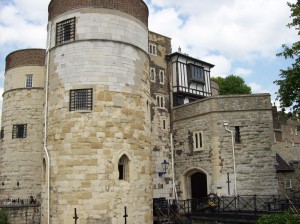
Anne Boleyn left the tennis match and presented herself in the council chamber in front of a royal commission consisting of the Duke of Norfolk (her uncle), Sir William Fitzwilliam and Sir William Paulet. There, she was informed that she was being accused of committing adultery with three different men: Mark Smeaton, Sir Henry Norris and a third, unnamed at this stage. She was also told that Smeaton and Norris had confessed. Anne remonstrated with her accusers, but her words had no effect and the royal commission ordered her arrest. Anne was then taken to her apartments until the tide of the Thames turned and then, at two o’clock in the afternoon, she was escorted by barge to the Tower of London.
Upon arrival at the Tower, it is likely that Anne would have entered through the Court Gate (Tower Gate) of the Byward Tower, rather than through Traitors’ Gate.1 She was met by Sir Edmund Walsingham, the Lieutenant of the Tower, and taken to the Royal Palace where she encountered the Constable of the Tower, Sir William Kingston. Kingston wrote letters to Thomas Cromwell to keep him informed of Anne’s behaviour and the things she said during her imprisonment. In a letter dated 3rd May, he wrote of Anne’s arrival at the Tower:
“On my lord of Norfolk and the King’s Council departing from the Tower, I went before the Queen into her lodging. She said unto me, “Mr. Kingston, shall I go into a dungeon?” I said, “No, Madam. You shall go into the lodging you lay in at your coronation.” “It is too good for me, she said; Jesu have mercy on me;” and kneeled down, weeping a good pace, and in the same sorrow fell into a great laughing, as she has done many times since.
“She desired me to move the King’s highness that she might have the sacrament in the closet by her chamber, that she might pray for mercy, for I am as clear from the company of man as for sin as I am clear from you, and am the King’s true wedded wife. And then she said, Mr. Kingston, do you know where for I am here? and I said, Nay. And then she asked me, When saw you the King? and I said I saw him not since I saw [him in] the Tiltyard. And then, Mr. K., I pray you to tell me where my Lord my father is? And I told her I saw him afore dinner in the Court. O where is my sweet brother? I said I left him at York Place; and so I did.
“I hear say, said she, that I should be accused with three men; and I can say no more but nay, without I should open my body. And there with opened her gown. O, Norris, hast thou accused me? Thou are in the Tower with me, and thou and I shall die together; and, Mark, thou art here to. O, my mother, thou wilt die with sorrow; and much lamented my lady of Worcester, for by cause that her child did not stir in her body. And my wife said, what should be the cause? And she said, for the sorrow she took for me. And then she said, Mr. Kyngston, shall I die without justice? And I said, the poorest subject the Kyng hath, hath justice. And there with she laughed.”2
Sir Henry Norris had been taken to the Tower of London at dawn that day and Mark Smeaton was also imprisoned there, the only one of the men to be kept in chains. George Boleyn would soon be joining them there.
Notes and Sources
Snippets from The Fall of Anne Boleyn: A Countdown by Claire Ridgway.
- Wriothesley, Charles. A Chronicle of England During the Reigns of the Tudors, from A.D. 1485 to 1559, 36. Also Stow, John. Annals of England to 1603, 964.
- Letters and Papers, Foreign and Domestic, Henry VIII, Volume 10 – January-June 1536, 793.